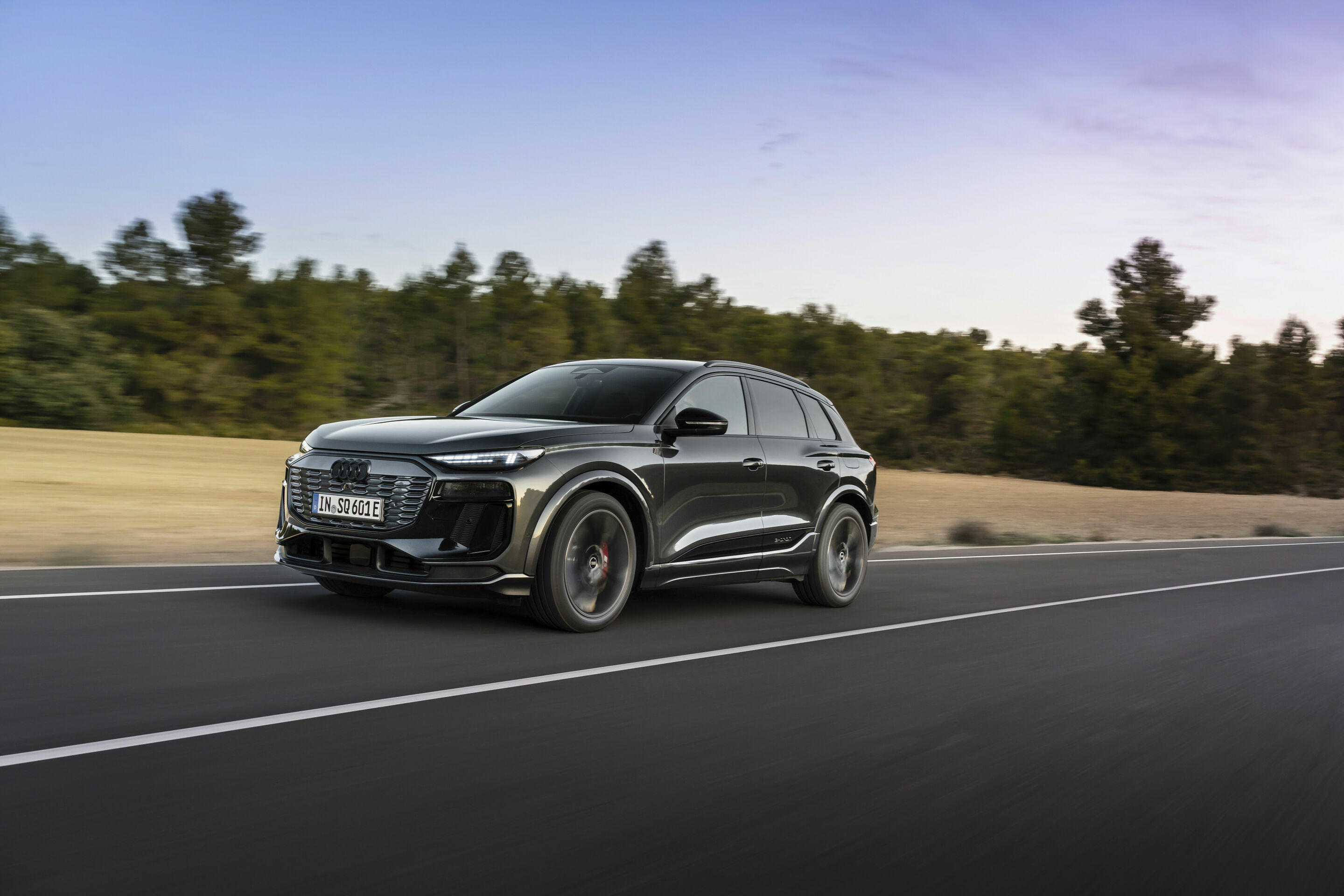Sporty performance: powerful drives
Back to overviewWhen developing the new electric motors, the focus was on a modular electric axle system with optimal acoustics, efficiency, and power density. Another goal of the development in this area was a scalable electric drive system with a high level of component integration. The completely newly developed modular drive system consists of three main components: electric motor, power electronics (pulse inverter), and transmission. All components are characterized by a higher degree of efficiency. They are more compact than the current electric models in the portfolio and have a scalable design. This means that the torque output can be varied by changing the length of the electric motor. The newly developed electric motors also require around 30 percent less installation space than those previously used in Audi's electrically powered models. The new design has also made it possible to reduce the weight by around
20 percent.
The particularly compact and efficient electric motors are built in Győr, Hungary. The largest powertrain plant in the world not only manufactures the electric motors but also a large proportion of the gearboxes.
A key advantage of the newly developed electric motors is their efficiency. This is primarily thanks to a new hairpin winding in the stator, silicon carbide semiconductors in the pulse inverter, as well as dry sump lubrication and an electric oil pump in the transmission. The new hairpin winding, which is being used in the Q6 e-tron for the first time at Audi, maximizes the current flow in the stator of the electric motor. This method also enables a higher number of windings: The fill factor is now 60 percent instead of the 45 percent reached with the conventional windings used previously. Thanks to rotor oil cooling, Audi was also able to largely dispense with the use of heavy rare earths and, at the same time, increase the power density by 20 percent. In total, the losses of the electric drives have been significantly reduced by around 50 percent compared to the Audi e-tron.
The new direct cooling of the electric motors with oil keeps components such as the stator winding and permanent magnets in the rotor in the optimum temperature range. As a result, the power-to-weight performance of the PPE's electric drive is around 60 percent higher than that of the first-generation electric drives from Audi. The newly developed electric drives for the PPE are also characterized by particularly quiet and comfortable acoustics. This is due in part to unit supports cast onto the housing, a structurally optimized housing, improved tooth geometries, and segmented staggered rotors.
When maximum performance is needed, an asynchronous motor (ASM) on the front axle is activated. It is equipped with its own power electronics and an axle-parallel, two-stage 1-speed gearbox. If required, the ASM can rotate freely without significant drag losses. In addition, no magnets are installed in the ASM, and therefore, no rare earths. The magnetic field is generated by induction.
On the rear axle, the Q6 e-tron series is equipped exclusively with particularly compact permanent-magnet synchronous motors (PSM), which are also coupled to a two-stage 1-speed gearbox with an axis-parallel design. The 800-volt technology used in the PPE not only offers high performance and short charging times. The higher voltage also means thinner cables can be used to wire the battery and electric motor. This saves installation space, weight, and raw materials. Another advantage of 800-volt technology is a reduction of heat loss and the resulting lower cooling requirements.
Thanks to the scalability and flexibility of the Premium Platform Electric, a wide range of different performance levels and drive variants can be realized. Two model variants with all-wheel drive and two different performance levels will be available at market launch: the Audi Q6 e-tron quattro and the Audi SQ6 e-tron. Particularly efficient models with rear-wheel drive designed for range will follow at a later date - depending on the market - and will also mark the entry into the Q6 e-tron series.
The Audi Q6 e-tron quattro has a permanent-magnet synchronous motor (PSM) on the rear axle and an asynchronous motor (ASM) on the front axle. The PSM in the Audi Q6 e-tron has an axial length of 200 millimeters (7.9 in). The ASM (asynchronous motor), which spins freely without any significant drag losses, is 100 millimeters (3.9 in) long. The system output is 285 kW (387 PS). The Q6 e-tron quattro accelerates from zero to 100 km/h (0-62 mph) in just 5.9 seconds (combined power consumption in kWh/100 km: 19.6-17.0 (WLTP); combined CO2 emissions in g/km:0; CO2 class A). Overall, the efficiency measures relating to the new electric motors for the PPE alone generate around 40 kilometers (25 mi) more range compared to the previous electric model portfolio. The newly developed electric motors for the PPE require around 30 percent less installation space than the units in the first-generation e-tron. The weight has been reduced by around 20 percent.
The Audi SQ6 e-tron is characterized by a system output of 360 kW (380 kW with Launch Control). The PSM on the rear axle has an axial length of 200 millimeters (7.9 in) in the Audi SQ6 e-tron.
The S model has a maximum range of 598 kilometers (372 mi). In Launch Control mode, the SQ6 e-tron reaches the 100 km/h mark in just 4.3 seconds. The power electronics have a significant influence on power consumption and consequently on efficiency and range. This is why semiconductors made of silicon carbide are being used for the first time in the PPE and, therefore, in the Audi Q6 e-tron. This material is extremely efficient, particularly under partial load, and heat losses can be kept to a minimum overall. The overall efficiency is improved. In addition, the use of silicon carbide protects the battery.
The equipment, data and prices specified in this document refer to the model range offered in Germany. Subject to change without notice; errors and omissions excepted.

